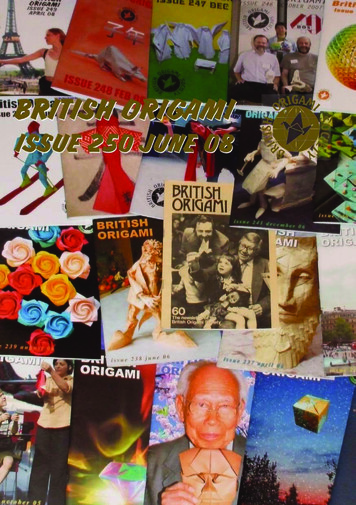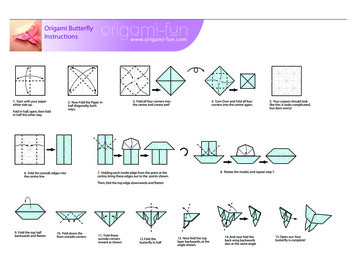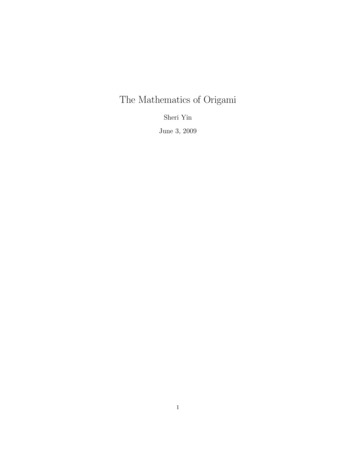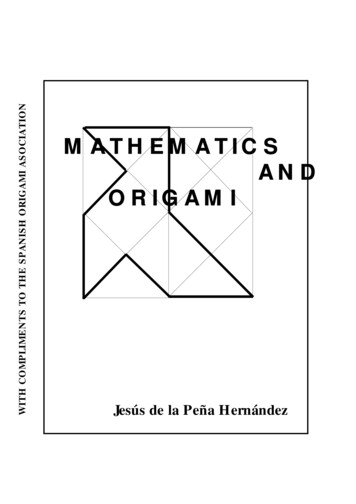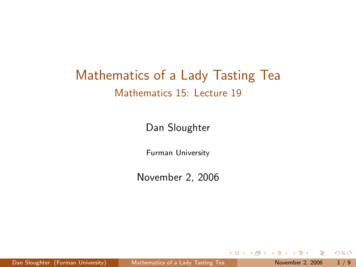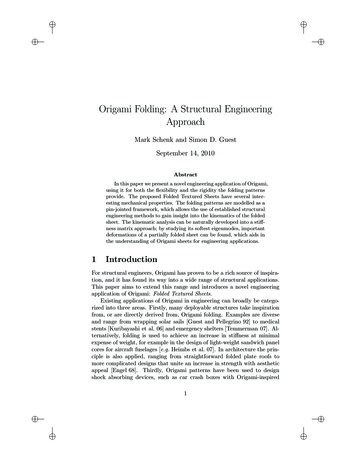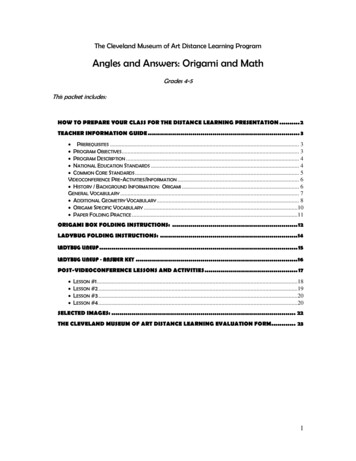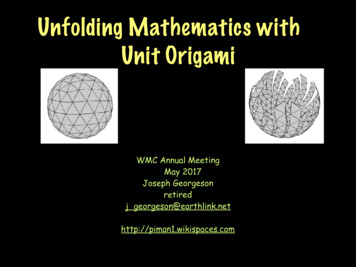
Transcription
Unfolding Mathematics withUnit OrigamiWMC Annual MeetingMay 2017Joseph Georgesonretiredj m
Assumptions:mathematics is the search for patternspatterns come from problemstherefore, mathematics is problem solving.algebra is the language of mathematicsknowing and describing change is importanttables, graphs, equations, words areeffective ways to describe changemath should be fun
Example-The Ripple EffectHow do the number ofconnections change as thenumber of people grows?
Two people.One connection.Three people.Three connections.Four people.? connections.
Tablepeopleconnections213346510615721
Graph
Verbal explanation:In a group of 10 people, each of the 10could be connected to 9 others.Those connections are all counted twiceme to you and you to me.Therefore the number of connections for10 people is
In General:people (people - 1)connections 2
This cube was madefrom 6 squares of paperthat were 8 inches oneach side.
Here are some other cubes, using the same unit,but starting with square paper of other sizes.The volume orsize of eachcube changes asthe size of thesquare that wasfolded changes.
here is the paper that was used-the paperranges insize from a3” square toan 8” square
First, we are going to build a cube.This process is called multidimensionaltransformation because we transformsquare paper into a three dimensional cube.Another more common name isUNIT ORIGAMI
two very useful books-highly recommended.Unit Origami,Tomoko FuseUnfoldingMathematics withUnit Origami,Key Curriculum Press
Start with a square.
Fold it in half, then unfold.
Fold the two verticaledges to the middle toconstruct these lineswhich divide the paperinto fourths. Thenunfold as shown here.
Fold the lower rightand upper left cornersto the line as shown.Stay behind thevertical line a little.You will see why later.
Now, double foldthe two corners.Again, stay behindthe line.
Refold the two sidesback to the midline.Now you see why youneeded to staybehind the line alittle. If you didn’t,things bunch upalong the folds.
Fold the upper right andlower left up and downas shown. Your accuracyin folding is shown byhow close the two edgesin the middle cometogether. Close is goodnot close could beproblematic.
The two cornersyou just folded,tuck them underthe double fold. Itshould look likethis.
Turn the unitover so youdon’t see thedouble folds.
Lastly, fold thetwo vertices of theparallelogram up toform this square.You should see thedouble folds ontop.
This is one UNIT.We need 5 more UNITS toconstruct a cube.
ChangeThe volume of the cube will change when different sizesquares are folded.The cubes you just made were made from 6” squares.What if the square was half as long?Is there a relation between the size of the square andthe resulting volume that we could show using a table,graph, or algebraic expression?
Gather DataRecord in a tableGraph on a gridDetermine the equationusing geogebra
Gathering Dataoriginalsquare123455.5678910number ofbuckets
Gathering Dataoriginalsquarenumber ofbucketsgroup 1group 2group 3group 072323.0083434.00910
What is “under” the unit that we just folded.Unfolding it reveals these lines.The center square is the face of the cube.If the square is 8” by 8”, what is the area ofthe square in the middle?
length oforiginalsquare246810resultinglength ofcuberesultingarea of oneface of cuberesultingvolume ofcube
length oforiginalsquareresultinglength ofcuberesultingarea of oneface of cuberesultingvolume 28822.627103.53512.544.194x2x82x8 x2 8 3
other uses for this unit:model volume, surface area, and lengthSierpinski’s Carpet in 3 dimensionsmodel the Painted Cube problemconstruct stellated icosahedron with 30units, stellated octahedron with 12 unitsand .
here is astellatedicosahedron30 unitsarerequired
this isaBuckyball,270units
asciencefairprojectdetermining howmanystructures the unitcanmake
entertaining grandchildren
Sierpinski’s carpet in 3 dimensions-
amodelforvolume
a wall of cubes!
Have you ever wanted an equilateral triangle?orHow about a regular hexagon?orA tetrahedron?orWhat about a truncated tetrahedron?
start withanyrectangular sheetof paper-
fold tofind themidline-
fold the lowerright cornerup as shown-
fold theupper rightcorner asshown-
foldover thelittletriangle-
sources that would be helpful:handout: this keynote is available in pdf form athttp://piman1.wikispaces.comUnit Origami, Tomoko FuseUnfolding Mathematics using Unit Origami, Key Curriculum Pressgeogebra.orgFold In Origami, Unfold ?id 28158
Origami SongI’d like to teach all kids to foldAnd learn geometryTo see how paper can be usedTo do or i gam i.I’d like to build a cube that beforeThe for mu la’s appliedTo show that volume all dependsOn the lengths of that cube’s sideI’d like to start with paper squaresAnd fold with sym me tryI use right angles here and thereTo make my squares 3-DChorus:That’s ge om e try, we learned here todayA song of math that echoes on and never goes awayA song of math that echoes on and never goes away.
Origami Song I’d like to teach all kids to fold And learn geometry To see how paper can be used To do or i gam i. I’d like to build a cube that before The for mu la’s applied To show that volume all depends On the lengths of that cube’s side I’d like to start with paper squares And fold with sym me try I use right angles here and there To make my squares 3-D Chorus: That’s ge om e .
